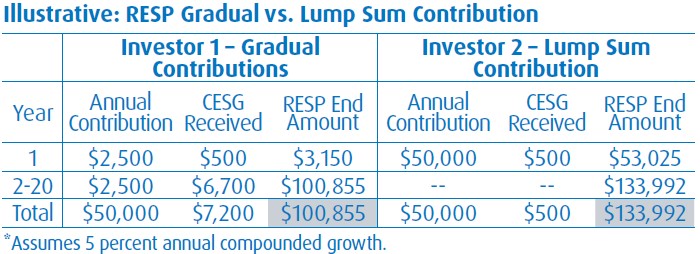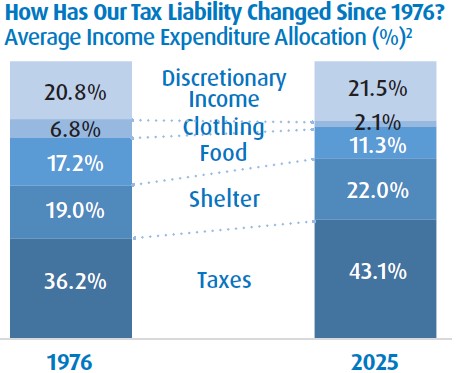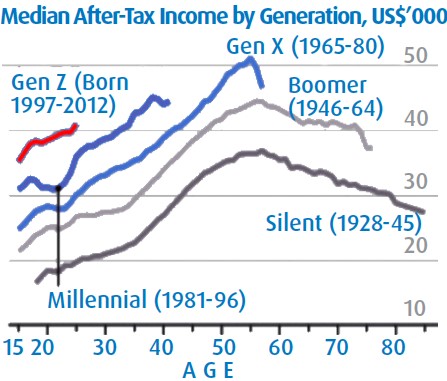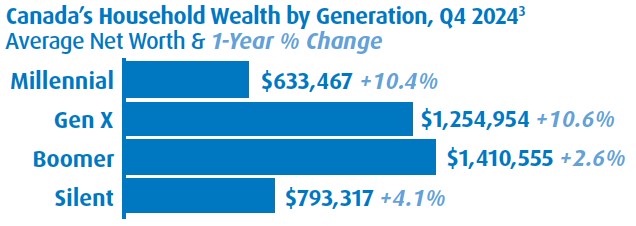Investment Insights Fall 2025
Paul D'Elia - Oct 07, 2025
- Estate Planning
- Financial Planning
- Investment Services
- Portfolio Management
- Retirement
- Special Reports and Newsletters
- Tax Planning
- Total Client Experience
- Wealth Management
In This Issue • Back-to-School Investing Lessons • Investing After Strong Market Periods • Why Tax Planning Is Ever More Important • Younger Generations: Going to Be All Right • Take A Break from Your Smartphone
Riding the Exponential Wave
Fold a piece of paper in half 42 times, and—beyond intuition—its thickness would reach the moon. What begins as small, trivial steps compounds into exponential growth, which may help explain why change today feels as though it has accelerated so rapidly.
After a summer of significant gains, equity market advances have created a degree of nervousness for some investors. Indeed, the rebound has been remarkable: Since the April lows, the S&P 500 surged more than 30 percent in two months, one of the fastest rallies in recent history, and the S&P/TSX hit multiple new all-time highs. While the underlying challenges have largely not changed, this optimism wasn’t entirely unfounded: economic growth has proven more resilient than expected, trade tensions have eased as new agreements are negotiated, and there’s a view that central banks will cut rates should conditions weaken.
Moreover, earnings season was buoyed by strength in large tech-related earnings—a familiar theme in recent years—and largely fuelled by market enthusiasm for artificial intelligence (AI). In the first half of the year, AI-related capital spending contributed more to U.S. GDP growth than consumer spending. Few doubt AI will be an economic driver in the years to come, but adopting any new technology doesn’t guarantee financial success for all early players. The questions now: Will AI live up to its transformative promise, comparable to innovations of the past like the steam engine or lightbulb? And, who will emerge as the winners?
Why Things Seem to Move So Quickly: The Exponential Curve
AI is not new—its roots go back to the 1950s with Alan Turing’s “Turing Test” for machine intelligence. What’s changed dramatically is the pace of progress, driven by exponential increases in computational power, vast datasets and advances in machine learning algorithms. To put it in perspective, the amount of data generated worldwide is expected to exceed 180 zettabytes in 2025. Compare that to the late 1980s, when annual data creation was measured in terabytes (1 terabyte = 0.000000001 zettabytes). Today, we find ourselves on the steep part of the exponential curve, where decades of slow, academic progress have given way to rapid, real-world breakthroughs. To use the analogy of folding a sheet of paper only 0.1 mm thick: seven folds make it notebook-thick, but 30 folds stretch 100 km into space. By 42 folds, its thickness exceeds 382,500 km—the distance to the moon! In investing, compounding works much the same way—slow at first, then powerful over time. This is why, as advisors, we often emphasize the principle: The first rule of compounding is to never interrupt it unnecessarily.
Where to From Here? With equities rallying from the April lows to hit all-time highs this past summer, many investors are asking: Where to from here? Indeed, the pendulum can quickly swing. Enjoy the upwave—momentum can be a powerful force that lasts longer than many expect—but remain mindful of headwinds: a slowing economy, lingering impacts of trade policy and potential volatility if expectations and optimism continue to run too far ahead. A diversified approach can help capture innovation’s upside while balancing exposure to keep portfolios resilient as conditions shift. Rebalancing along the way can lock in gains and thoughtfully redeploy capital. Investing, at its core, involves discipline, diversification and the tenacity to endure
short-term uncertainty in pursuit of long-term results. These principles have served investors well through countless cycles and remain as relevant as ever in today’s fast-moving markets.
Back-to-School Investing Lessons
Turn down “free” money? Consider the impact of compounding over time by frontloading the RESP and foregoing the CESG.
There are many reasons to consider a Registered Education Savings Plan (RESP) to save for a child’s future education: tax-deferred growth within the plan, income-splitting for high-net-worth families (as earnings are taxed at the child’s tax rate when eventually withdrawn) and, of course, the Canada Education Savings Grant (CESG): funds paid into the plan by the federal government as a 20 percent matching grant, to an annual maximum of $500 ($1,000 if unused grant room from a previous year) and a lifetime maximum of $7,200 per beneficiary. There are no annual limits on RESP contributions; however, the lifetime limit is $50,000.
Conventional wisdom suggests we should take advantage of the CESG; after all, it’s essentially “free” money. But is this always the best decision? One way to maximize the CESG involves contributing $2,500 per year over 15 years to receive the full $7,200 in grants. However, will this achieve the greatest outcome for the RESP?

To answer this question, let’s compare Investor 1, who gradually contributes and maximizes the CESG, and Investor 2, who contributes a lump sum amount and doesn’t maximize the CESG. The outcome may be surprising. Both investors are assumed to earn an annual rate of return of 5 percent. Investor 1 contributes $2,500 each year starting in the first year of the child’s life until year 20, to a maximum contribution of $50,000, and receives the full $7,200 CESG grant. After 20 years, the RESP produces $43,655 of growth, resulting in a value of $100,855. Investor 2 contributes a lump sum of $50,000—the full RESP limit—in the first year of the child’s life, so the RESP receives only $500 of CESGs. Yet, the RESP grows to $133,992 over the same period.
This shows the profound impact of compounding over time. Frontloading the initial contribution yields a larger outcome, even without receiving the full CESG, all else being equal. Despite lower overall contributions for Investor 2, or $6,700 less in CESGs, the outcome is $33,137 greater.
A Lesson for the RESP and Investing in General: Time Can Be Powerful
Of course, not many investors have $50,000 of discretionary funds at the start of a child’s life. As such, maximizing the CESG where possible is a
prudent strategy. Yet, this example illustrates why, as advisors, we often remind investors not to overlook the impact that compounding can have over time on any investment—not just the RESP. The key takeaways? The sooner you start, the more time funds have to grow and, when it comes to growth, the larger the initial investment, the better!
Investing After Strong Market Periods
“The strongest of all warriors are these two: Time and Patience.”
— Leo Tolstoy
Following the notable gains in both Canadian and U.S. equity markets after April’s lows, investors may feel hesitant about the prospect of putting money to work. Here are two common myths, debunked, about investing after periods of strong market performance:
Myth 1: Investing at all-time highs means substantially lower returns. While investors can benefit from the practice of buying low and selling high, perceived highs can still allow for growth. Investing only at market highs may not be as unfavourable as many believe. Since 1950, the returns from investing in the S&P 500 only at all-time highs wouldn’t be far from the average index when investing at all other dates for one-, three- and five-year periods.


Myth 2: Market corrections often follow market highs. In reality, market corrections (declines of more than 10 percent) are not especially
common after all-time highs. The chart (top) shows how often the S&P has experienced such drops after over 1,250 all-time highs since 1950.
Of course, corrections are a normal part of the cycle. Markets go down just as they go up. But avoiding equities simply because they’re at record levels
amounts to trying to time the next downturn. Staying invested with a long term horizon has proven more effective. Even an investor who invested in the S&P 500 at its peak in late 1999, before the dot-com bubble burst, would still have achieved an annualized return of nearly 8 percent today.2
This isn’t to suggest that recent rapid gains will continue at a similar pace. Indeed, we find ourselves in a period where strategic security selection matters more than ever—and this is where our work as advisors shines through. Enjoy the gains of recent times, but don’t overlook the importance of time and patience in building wealth for the future.
1. https://www.rbcgam.com/en/ca/learn-plan/investment-basics/investing-at-all-time-highs/detail;
2. S&P 500 Total Return Index (dividends reinvested), 12/31/1999: 2,021.4; 07/31/2025: 14,020.46.
Why Tax Planning Is Ever More Important
As you plan before year-end, don’t overlook the carryforward rules.
Despite rising living costs, the share of income spent on necessities has declined. In 1976, households spent around 43 percent of their income on shelter, food and clothing; today, this is around 35 percent.1 What has risen is our tax burden. In 2025, the average Canadian family will pay 43.1 percent in taxes. Put differently, if taxes were paid upfront, the first 158 days’ earnings would go entirely to the government!
Given our rising tax burden, tax planning has never been more important. As you plan for year-end, remember that the tax rules allow you to carry forward certain unused credits or deductions. Here are some tips.
Capital Losses — If you sell investments in a non-registered account for less than the original cost, the resulting capital loss can be used to offset capital gains realized during the year. If you don’t have sufficient capital gains, the net capital loss can be carried back three taxation years, or carried forward indefinitely to use against net capital gains. Tip: Be aware of the superficial loss rules, which may deny the loss if you or an affiliated entity acquires the same security 30 days before/after the date of the loss transaction.
Registered Retirement Savings Plan (RRSP) — Unused RRSP contribution room and unused RRSP deductions can be carried forward. Tip: Contribute before the March 2, 2026, deadline to maximize potential tax-deferred growth. You may defer claiming the deduction to a higherincome year to offset a larger tax bill.
TFSA — Unused TFSA contribution room can be carried forward indefinitely. Tip: If you need TFSA funds, consider withdrawing before year-end. Contribution room resets itself at the start of the calendar year, so withdrawing after December 31, 2025, means the contribution room
won’t be available until January 1, 2027.
RESP — While the CESG pays an annual maximum of $500, unused grant room can carry forward to a maximum of $1,000 per year ($500 current year
+ $500 carryforward). Tip: If you missed a prior year contribution, consider an annual contribution of $5,000 to achieve the maximum grant.

First Home Savings Account (FHSA) — FHSA holders can contribute $8,000 annually in participation room. Unused amounts can be carried forward to the following year, but only to a maximum of $8,000 per year and subject to a lifetime limit of $40,000. Tip: The FHSA closes at the end of the year of its 15th anniversary or the year after the first qualifying withdrawal. Not contributing the full $8,000 from the onset could cause you to miss out on the lifetime limit and valuable tax-deductible benefits. Maximizing contributions early helps boost potential tax-free growth.
Charitable Donations — Eligible donations unused in the current year can be carried forward for up to five tax years. This is especially helpful for donations made to U.S. charities, which can typically only be claimed against U.S. source income earned in the year the credit is claimed. Tip: Donating shares “in kind” to an eligible Canadian charity allows you to receive a donation receipt for their fair market value. If the shares in a non-registered account have appreciated, this strategy can also help eliminate the capital gains tax liability.
1. https://www.fraserinstitute.org/commentary/canadian-families-must-work-nearly-half-year-pay-taxes;
2. https://www.fraserinstitute.org/sites/default/files/2025-07/canadian-consumer-tax-index-2025.pdf
Younger Generations: Going to Be All Right
Despite facing one of the toughest job markets in decades and a difficult path to homeownership, Gen Z is doing just fine.
A recent Economist article, “Generation Z is Unprecedentedly Rich,” noted that at the same age, Gen Z incomes are 50 percent higher than Boomers’.1
They’re also saving better, contributing more to retirement plans than Millennials did when entering the workforce. In 2023, the median RRSP
contribution for Canadians under 25 was over 20 percent higher than that of Millennials in 2009.2
The more provocative headline, “Why Gen X is the Real Loser Generation,” suggests the cohort struggling most is Gen X, stuck in the “u-bend of life,” caring for both children and aging parents.

Gen X incomes were only 16 percent higher than Boomers at the same age, the smallest gain of any group, likely due to a weak labour market after the Global Financial Crisis. Still, the big picture is positive. Canadian household wealth hit a record $17.49 trillion to end 2024, with average net worth up 30 percent from pre-pandemic levels to $1,026,205. Every generation saw gains.
The outlook? It looks good. As with previous generations, we figured it out—and it appears Gen Z is doing the same, perhaps even faster.

1. https://www.economist.com/finance-and-economics/2024/04/16/generation-z-is-unprecedentedly-rich;
2. https://www.theglobeandmail.com/investing/personal-finance/retirement/article-retirement-savingsgen-z-canadians/; 3. https://financialpost.com/wealth/canadian-households-worth-more-million-2024
Investing Focus: Take A Break from Your Smartphone

Here are six perspectives on how our hyperconnected world may be impacting our investing focus, and why unplugging may be more beneficial than you’d expect:
Shorter Holding Periods Can Hurt Returns — Today, the average holding period for a stock has dropped to around five months, down from nearly eight years in the 1960s.1 With platforms offering real-time data and near-instant execution, it’s easy to conflate access with insight, which may encourage more frequent trading. Yet, studies continue to show that this comes with costs: the average underperformance by the most active traders annually (versus the U.S. stock market) is around 6.5 percent.2
Technology Drives Impulsive Purchase Decisions — Quite alarmingly, a recent study by NYU Stern researchers found that the median individual investor spends just six minutes researching a stock before buying it online.3 Technology continues to accelerate the speed at which we access, process and react to information, likely encouraging impulsive investor behaviour. Beyond investing, consider this: for every 100-millisecond improvement in load time, Amazon reportedly sees a one percent boost in revenue.4 Speed influences behaviour.
Constant Checking Can Make Us Feel Worse — By one account, the average person checks their phone 352 times a day, about once every 2 minutes and 43 seconds.5 Checking portfolios more frequently increases the chance of seeing a loss: daily monitoring of the S&P/TSX Composite Index shows negative performance 48 percent of the time versus just 28 percent when checked annually. After five years, the chances of seeing a negative return drop to under 3 percent. Losses tend to feel twice as painful as equivalent gains feel rewarding. Doomscrolling Amplifies Anxiety — Many of our phone checks lead to news headlines, social media and “doomscrolling,” a term officially added to the Merriam-Webster dictionary in 2021. Many studies on mental health suggest that reducing screen time, especially doomscrolling, can lead to significant reductions in anxiety and depression symptoms, some within just weeks.6
Negative Bias Distorts Investment Perspective — Our brains are hardwired to focus on threats—a survival instinct that makes negative news more attention-grabbing. Media outlets know this and tailor their headlines accordingly. During periods of heightened fear, studies have also found that social media increases herd behaviour among investors. The result? Emotional decision-making that may not serve long term goals.7
It May Also Waste Valuable Time — According to some statistics, the average adult spends about 4 hours and 39 minutes a day on their phone, or roughly 70 full days per year.8 Over a 60-year adult life, that adds up to nearly 12 years of screen time! Smartphones can support productivity, but if you’ve ever lost an hour to TikTok or Instagram, it’s worth asking: how much of life is being traded for scrolling?
Why Not Take a Break From Your Smartphone?
In a world that is constantly connected, why not consider unplugging? We are here to support your longer term wealth plan, built to do the heavy lifting—freeing you to focus your time and attention on what matters most.
1. https://www.visualcapitalist.com/the-decline-of-long-term-investing/; 2. https://advisor.visualcapitalist.com/20-most-common-investment-mistakes/; 3. https://www.wsj.com/finance/investing/buying-stocks-research-study-2a839a4a; 4. https://www.forbes.com/sites/steveolenski/2016/11/10/why-brands-are-fighting-over-milliseconds/; 5. https://www.asurion.com/connect/news/tech-usage/; 6. https://bmcmedicine.biomedcentral.com/articles/10.1186/s12916-025-03944-z; https://www.researchprotocols.org/2024/1/e53756/; 7. https://www.sciencedirect.com/science/article/abs/pii/
S1059056023001326; 8. https://www.statista.com/statistics/1045353/mobile-device-daily-usage-time-in-the-us/
To Our Clients:
As routines shift this time of year, change may
be particularly abundant. Many are gearing
up for a busy season: kids back at school,
others returning to the office (RTO), and
some snowbirds planning alternative travel
destinations. If your personal situation has
shifted recently, it might be a good time to
review your wealth plan.
With the school year underway, it’s a timely
reminder to consider education funding. Ensuring
our families have the financial means to support
educational priorities is more important than ever
with rising costs. An investment program can be a
smart way for (grand)parents or family members
to provide that support and leave a lasting legacy.
With the changing seasons, here’s to warm
markets for the cooler days ahead.
D’Elia Wealth Advisory Group
BMO Nesbitt Burns
Paul D’Elia
B.Comm. (Hons), CIM®, PFP®, FCSI®
Senior Wealth Advisor
Senior Portfolio Manager
BMO Private Wealth is a brand name for a business group consisting of Bank of Montreal and certain of its affiliates in providing private wealth management products and services. Not all products and services are offered by all legal entities within BMO Private Wealth. Banking services are offered through Bank of Montreal. Investment management, wealth planning, tax planning, and philanthropy planning services are offered through BMO Nesbitt Burns Inc. and BMO Private Investment Counsel Inc. Estate, trust, and custodial services are offered through BMO Trust Company. Insurance services and products are offered through BMO Estate Insurance Advisory Services Inc., a wholly-owned subsidiary of BMO Nesbitt Burns Inc. BMO Private Wealth legal entities do not offer tax advice. If you are already a client of BMO Nesbitt Burns Inc., please contact your Investment Advisor for more information. BMO Nesbitt Burns Inc. is a Member – Canadian Investor Protection Fund and is a Member of Canadian Investment Regulatory Organization. BMO Trust Company and BMO Bank of Montreal are Members of CDIC. “BMO (M-bar roundel symbol)” is a registered trademark of Bank of Montreal, used under licence.
BMO Private Wealth provides this publication for informational purposes only and it is not and should not be construed as professional advice to any individual. This newsletter was produced by J. Hirasawa & Associates, an independent third party for the individual Investment Advisor noted. While every effort is made to ensure that the contents have been compiled or derived from sources believed to be reliable and contain information and opinions which are accurate and complete, the author does not accept responsibility or liability resulting from the information or content provided. The information contained in this publication is based on material believed to be reliable at the time of publication, but BMO Private Wealth cannot guarantee the information is accurate or complete. Individuals should contact their BMO representative for professional advice regarding their personal circumstances and/or financial position. The comments included in this publication are not intended to be a definitive analysis of tax applicability or trust and estates law. The comments are general in nature and professional advice regarding an individual’s particular tax position should be obtained in respect of any person’s specific circumstances.
BMO Private Wealth is a brand name for a business group consisting of Bank of Montreal and certain of its affiliates in providing private wealth management products and services. Not all products and services are offered by all legal entities within BMO Private Wealth. Banking services are offered through Bank of Montreal. Investment management, wealth planning, tax planning, philanthropy planning services are offered through BMO Nesbitt Burns Inc. and BMO Private Investment Counsel Inc. If you are already a client of BMO Nesbitt Burns Inc., please contact your Investment Advisor for more information. Estate, trust, and custodial services are offered through BMO Trust Company. BMO Private Wealth legal entities do not offer tax advice. BMO Trust Company and BMO Bank of Montreal are Members of CDIC.
® Registered trademark of Bank of Montreal, used under license.
